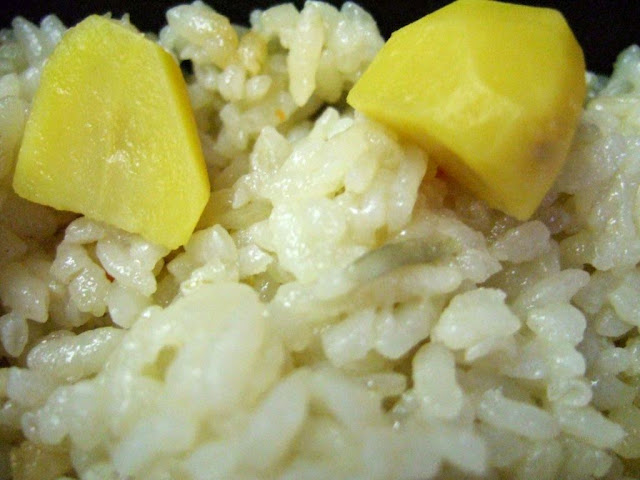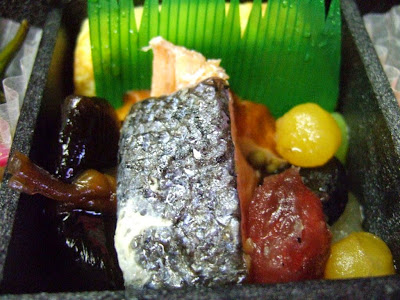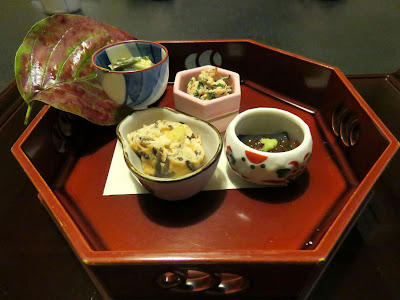
Being Japan's former capital and seat of imperial court for more than a thousand years, Kyoto offers a rich culinary tradition. The city has ranges of diverse food. The main categories include the elite courses dinner of Yusoku Imperial and Kaiseki Ryori, Temple styled vegetarian Shojin Ryori, and simple home-cooked Obanzai Ryori. Though some of the local food stalls begin to accept and experiment with new flavors, many restaurants within the city are still inspired from the past history.


Kaiseki Ryori is one of the five aristocratic course-dinner in Kyoto tradition and is the most common offered by most restaurants. It consists of about 10 courses served from starter followed by boiled soup, raw fish, main course, fried tempura, grilled fish, steam egg, rice + pickle + miso soup, desert or fruits. Price varied from 50-150 US dollars per head. If you have Kaiseki Ryori as dinner in some famous restaurants around Gion District, entertainment of geisha can be arranged. We are considered to be quite lucky to meet a geisha face to face in the restaurant where we had our dinner. She was dated by the guests seated next to our room and we could hear her singing while enjoying our Kaiseki Ryori. (photographing is strictly prohibited).



The Kaiseki Ryori in Kyoto compared to other part of Japan is more refined. It emphasizes on subtle flavor and local seasonal ingredients. The taste of each dish determined very much by the method of cooking and preparing of the chef.



One of the interesting dishes in our Kaiseki Ryori include a mouthful of this little awakening tea pot soup. The taste is so perfect with just few drops of fresh lime juice.



The Tempura after deep fried can be taken right away from the frying pot or soaked in the sauce then only eat it.


The rice traditionally prepared in a mini wooden ancient rice maker with holes underneath, usually came after all other dishes before the desert.


The desert and tea are served last. Kaiseki Ryori was originated from tea ceremony and gradually developed into elaborate dinning style among aristocratic societies.



The local specialty of Kyoto is bean curd. It is the main ingredient in vegetarian Shojin ryori temple meals. We had it for our lunch. The soft tofu simmered with vegetables broth is commonly known as Yudofu. Many Kaiseki Ryori also include this dish.


Vegetable Tempura and raw fresh root are another two common dishes in Temple meals.


Izakaya Dining shops are traditional casual places where men drank sake and beer after work. It offers wide variety of menu items. People usually begin with a drink followed by sushi or boiled salted soybean pods (edamame) then grilled chicken skewers (yakitori), fried chicken (karaage) or any other more robust flavors dishes. The meal usually ended with a bowl of rice or noodle. The salmon and plum rice prepared by the Izakaya near Kyoto Station tasted real good.


I tried the mustard radish when I first time visited Kyoto and the taste had been with me in my memory, never want to fade away. I was overwhelmed to find it again in this shop. This is the dish that I was looking for in the past 10 years. And to my surprise, the grilled mustard eggplant also gives out the same charm.


Grilled fish and shrimp cake are another two favors to us. Food served from Izakaya Dining places are very tempting but smoking environment made us hard to breath.


Nato squid and Japanese chicken rice are really very special and we also love its wild vegetables salad with black vinegar sauce .



The US$10.00 home-cooked breakfast prepared by our Ryokan owner.



Isetan at Kyoto Station supplies varieties of Bento sets choices and price has a cut of 20-50 percent every day after 8pm. We bought a box of press sushi and a set of Bento at half price for our late dinner.



Kyoto Station has many kiosks selling Bento sets with seasonal produce to convenient train passengers when traveling. We had this fall Bento set with chestnut rice and four other dishes at US$8.80. The food are fresh, delicious and filling too.


The 4 compartments of our Kyoto bento set contains quite a balance diet. It has grilled salmon fish, seaweed, pickles, pumpkin, sweet potato, yam, walnut, meat ball, vegetables/pickles and some unnamed seasonal produce.



There are also restaurants serving Bento dishes as dinning on table. We were introduced by two of its local guests when we passed by the shop. We were served with this beautifully set Bento in a private room at a restaurant near Nishiki Market.


The home cooked Obanzai Ryori was made up of multiple small and simple dishes prepared from seasonal produce.





The grilled vegetable especially its green pepper though simple but tasted so well!


Many lunch and dinner sets come with a teapot soup but all differ from taste.


The teapot soup always boiled with portion of seafood like shrimp and fish. The taste is brought up perfectly with few shredded aromatic herb and few drops of fresh lime juice.


This was the first time I had vegetarian sushi with red miso soup


The seasonal chestnut cake!



Eating environment is one of the considerable factors to almost all restaurants in Kyoto. Guests of this restaurant are served in a private room with window viewing the outside koi garden. It is not only privacy, romantic but comfortable and relaxing. Japanese undoubtedly are people who knows how to enjoy the food most.



The elegant Japanese server who I assumed should be the owner of the restaurant.


Taking a picture with the chef who delayed his resting time to prepare the food for us.


The Temple vegetarian Yudofu set meal mainly made up of dishes from bean curd and plants. The price varies from 30 to 50 US$ per person.


The famous Soon-Zhen Tofu restaurant located just near the Temple of Nanzen-ji .

No comments:
Post a Comment